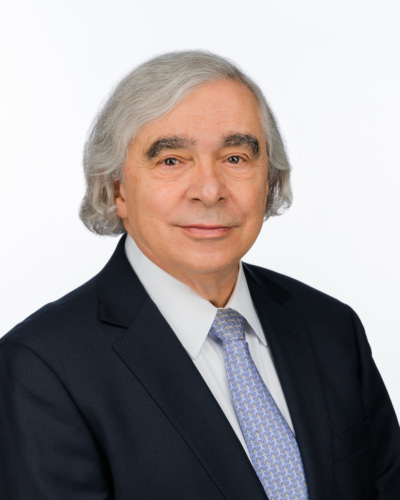
Ernest J. Moniz
Co-Chair and Chief Executive Officer, NTI
This article originally appeared in NBCNews.com on August 6, 2020.
In his stunning 1946 book, "Hiroshima," journalist John Hersey recounts the day just a year earlier when the atomic bomb Little Boy lit the sky and flattened that bustling Japanese city. Four decades later, Hersey talked to some of the survivors again. The Rev. Kiyoshi Tanimoto, who survived by wedging himself between two large rocks in a garden as the timbers of a house rained down, was then in his 70s. "His memory, like the world's, was getting spotty," Hersey reported.
Today, 75 years after the United States dropped atomic bombs on Japan, we must remember and honor the memories of Tanimoto and the other victims and survivors by reducing the danger that a nuclear bomb will ever be used again.
I was born but not yet walking in August 1945, and it would be years later, as a nuclear physics student, that I studied the work of Enrico Fermi. Fermi was responsible for creating the world's first nuclear chain reaction — a feat that would lead to nuclear medicine and clean energy but also to unfathomable destruction. Fermi summarized it succinctly in a physics lecture while pointing to the nucleus of an atom: "Here be dragons."
That three-quarters of a century have passed without another nuclear detonation in conflict — even as the number of countries with nuclear weapons, materials and technology has grown — can be attributed to a remarkable mix of diligence and diplomacy, grace and good luck.
The long Cold War between the West and the Soviet Union ended without a nuclear strike, and thankfully, we have not seen the use of nuclear weapons in unstable regions where they exist — from the Middle East to Southeast Asia to the Korean Peninsula.
However, as I understood while serving as U.S. secretary of energy, responsible for our nation's nuclear stockpile and key nonproliferation programs, there have been more close calls along the way than most people realize.
Now, as we lose the last of the generation that remembers when the nuclear bombs fell and as memories of the nerve-wracking U.S.-Soviet nuclear arms race — like those of Hiroshima — get spotty, we must awaken the world to a new and terrible truth: Nearly 30 years after the Cold War, the risk of a nuclear weapon's being used is higher than at any other time since the U.S. and the Soviets came to the brink of nuclear war during the Cuban Missile Crisis.
Not many years after President John F. Kennedy steered us through that crisis in 1962, 46 countries came together to collectively pledge to reduce the grave threat posed by nuclear weapons. They did so by signing on to the Treaty on the Non-Proliferation of Nuclear Weapons. The NPT, which today has 191 signatories, remains the foundation for preventing the spread of nuclear weapons.
Under the central bargain of the treaty, countries without nuclear weapons pledged never to acquire them, and the countries with nuclear weapons agreed to pursue disarmament and to share nuclear technology for peaceful uses. In some important ways, the treaty has been a success: It has significantly limited the number of countries with nuclear weapons, and it has fostered progress on nuclear arms reductions.
Today, however, disarmament efforts have stalled, and just as the coronavirus has taught us powerful lessons about our inability to respond to a global pandemic, it is time to challenge traditional thinking about nuclear weapons policies and reconsider our approach to reducing nuclear risks. After all, when the NPT and bilateral arms control agreements with the Soviet Union were signed, no one envisioned the advent of hypersonic weapons, cybertechnology and artificial intelligence, to name just a few changes driving new 21st century threats.
We now face dangers such as well-funded terrorist organizations with global reach, access to nuclear know-how and a determination to develop and use weapons of mass destruction — and 22 countries with weapons-usable nuclear materials, some of it poorly secured.
And we face cyberattacks that pose threats not just to banks and big box stores. Nuclear power plants and weapons command-and-control and early warning systems are also potentially vulnerable — and the results could be catastrophic.
We also continue to deal with some long-standing threats, chief among them the nuclear weapon advances in North Korea, which withdrew from the NPT in 2003.
And then there's the breakdown of arms control treaties, the essential guardrails around weapons of mass destruction, among them treaties to reduce and limit the sizes of the U.S. and Russian arsenals and the 2015 Iran nuclear agreement I helped negotiate with Secretary of State John Kerry to ensure that Iran does not develop nuclear weapons.
If the U.S. and Russia do not extend the New START treaty by February, it will be the first time in many decades that we do not enjoy mutual constraints on nuclear weapons and inspection rights.
These threats, however, can be reduced. We can build on the successes of the past, remembering that since the peak of the Cold War in the mid-1980s, the nuclear arsenals of the United States and Russia have been reduced by 85 percent.
We can start by getting back to basics and acknowledge that using nuclear weapons is not a rational option, as Ronald Reagan and Mikhail Gorbachev did in 1985 when they declared jointly that "a nuclear war cannot be won and must never be fought."
Nuclear weapons, like climate change and novel biological agents, pose an existential threat to our planet and our future.
What if the U.S. and Russian presidents — and perhaps China with the other permanent members of the U.N. Security Council, the United Kingdom and France — reaffirmed that statement?
Doing so might make some important next steps easier — like extending the remaining arms-reduction treaty between Washington and Moscow and negotiating additional agreements, renewing dialogue to help make sure a nuclear strike does not happen by mistake and engaging countries with nuclear weapons on how to ensure that cyberattacks do not target nuclear systems.
As we mark the 75th anniversary of the bombings that ended World War II, we must call on leaders around the globe to redouble their efforts to prevent a modern-day Hiroshima. As individuals, we also have a responsibility to speak out. Nuclear weapons, like climate change and novel biological agents, pose an existential threat to our planet and our future.
Two years ago, I made my first visit to Hiroshima. It was an extraordinarily moving experience to walk through Hiroshima Peace Memorial Park and see the haunting skeleton of the Genbaku Dome.
I was also struck by a photo in the park's museum, taken only weeks after the blast. A small green shoot of a plant had found the sun through the rubble, elegantly capturing the resilience and persistence of Hiroshima's people, who rightfully keep us focused on avoiding future nuclear catastrophe. We must not fail them.
Ernest J. Moniz is co-chair and CEO of the Nuclear Threat Initiative, a nonprofit, nonpartisan global security organization focused on reducing nuclear and biological threats imperiling humanity. Moniz served as the U.S. secretary of energy from 2013-17.
Sign up for our newsletter to get the latest on nuclear and biological threats.
There is a critical need for a global diplomatic approach to address growing cyber risks, including, where possible, through cooperation between the United States and Russia.
“The bottom line is that the countries and areas with the greatest responsibility for protecting the world from a catastrophic act of nuclear terrorism are derelict in their duty,” the 2023 NTI Index reports.
Christopher Nolan's Oppenheimer is the most high-profile film about nuclear weapons ever made.


